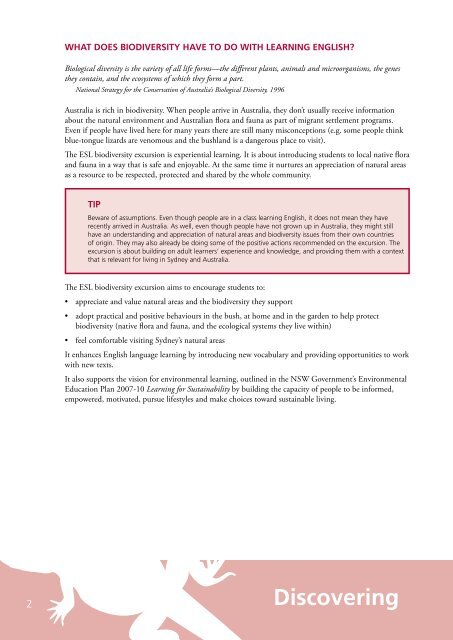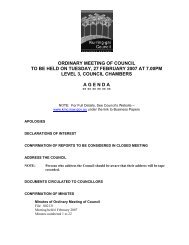ESL Resource Kit (pdf. 2MB) - Ku-ring-gai Council
ESL Resource Kit (pdf. 2MB) - Ku-ring-gai Council
ESL Resource Kit (pdf. 2MB) - Ku-ring-gai Council
You also want an ePaper? Increase the reach of your titles
YUMPU automatically turns print PDFs into web optimized ePapers that Google loves.
What does biodiversity have to do with learning English?<br />
Biological diversity is the variety of all life forms—the different plants, animals and microorganisms, the genes<br />
they contain, and the ecosystems of which they form a part.<br />
National Strategy for the Conservation of Australia’s Biological Diversity, 1996<br />
Australia is rich in biodiversity. When people arrive in Australia, they don’t usually receive information<br />
about the natural environment and Australian flora and fauna as part of migrant settlement programs.<br />
Even if people have lived here for many years there are still many misconceptions (e.g. some people think<br />
blue-tongue lizards are venomous and the bushland is a dangerous place to visit).<br />
The <strong>ESL</strong> biodiversity excursion is experiential learning. It is about introducing students to local native flora<br />
and fauna in a way that is safe and enjoyable. At the same time it nurtures an appreciation of natural areas<br />
as a resource to be respected, protected and shared by the whole community.<br />
Tip<br />
Beware of assumptions. Even though people are in a class learning English, it does not mean they have<br />
recently arrived in Australia. As well, even though people have not grown up in Australia, they might still<br />
have an understanding and appreciation of natural areas and biodiversity issues from their own countries<br />
of origin. They may also already be doing some of the positive actions recommended on the excursion. The<br />
excursion is about building on adult learners’ experience and knowledge, and providing them with a context<br />
that is relevant for living in Sydney and Australia.<br />
The <strong>ESL</strong> biodiversity excursion aims to encourage students to:<br />
• appreciate and value natural areas and the biodiversity they support<br />
• adopt practical and positive behaviours in the bush, at home and in the garden to help protect<br />
biodiversity (native flora and fauna, and the ecological systems they live within)<br />
• feel comfortable visiting Sydney’s natural areas<br />
It enhances English language learning by introducing new vocabulary and providing opportunities to work<br />
with new texts.<br />
It also supports the vision for environmental learning, outlined in the NSW Government’s Environmental<br />
Education Plan 2007-10 Learning for Sustainability by building the capacity of people to be informed,<br />
empowered, motivated, pursue lifestyles and make choices toward sustainable living.<br />
2<br />
Discove<strong>ring</strong>

















